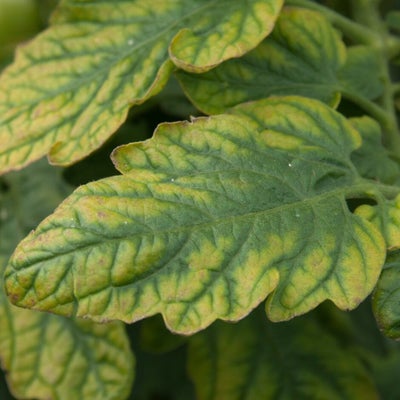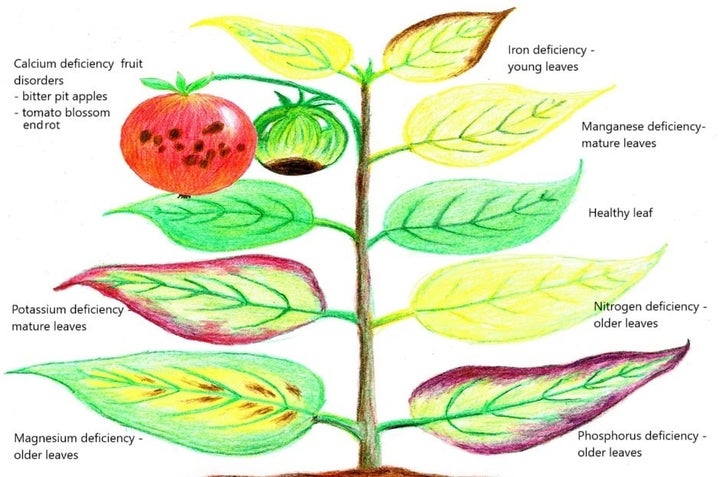
Quick facts
Any plant can be affected by nutrient deficiencies
Deficiencies can be helped by improving the soil and using fertiliser
Plants growing on very acidic, alkaline and sandy soils are more likely to develop deficiencies
Symptoms are usually seen in spring and summer
Plants in pots often show signs when nutrients run out
In dry soils and containers, roots can’t take up nutrients
Issues with growing conditions can resemble deficiencies
What are nutrient deficiencies?
They are a shortage or imbalance of the required for growth.
- The main nutrients (macronutrients) plants need are nitrogen, phosphorus, potassium, calcium, magnesium and sulphur.
- Trace elements (micronutrients) such as boron, chlorine, copper, iron, manganese, molybdenum and zinc are needed in smaller amounts for healthy plant growth.
Some deficiencies exhibit similar symptoms, making accurate identification challenging. Analysis of leaf tissue is offered by specialist laboratories, but this is very expensive.
What are the symptoms?
Deficiencies cause plants to grow poorly and show a range of symptoms. Use this diagram to help you identify which deficiencies you have on your plants.

Good to know
Issues with growing conditions including drought, waterlogging, light deprivation or poor establishment can resemble deficiencies. So, if your plants fail to thrive, despite good soil preparation, watering and mulching, nutrient deficiency is more likely.
Symptoms, cause and remedy
Use the nutrient deficiency shown above to help you match the symptoms to the potential remedies.
Nitrogen (N) – needed for green and leafy growth
Deficiency symptoms: Spindly, stunted plants with pale yellow leaves and, occasionally, pink tints. Older leaves are affected first, but the yellowing spreads to younger foliage.
Cause: A lack of nitrogen. This nutrient is easily washed out of the soil by rain and from by watering. Soil can be deficient by spring and compost in containers after a few months use. However, poor spring growth of plants in the ground could also stem from winter waterlogging, frost damage or cold weather.
Remedy for containers: Plants need a general-purpose liquid feed, for example – Miracle-Gro® Performance Organics Fruit & Veg Concentrated Liquid Plant Food.
Remedy for the ground: Long-term improvements can be made by mulching with organic matter (such as garden compost, manure or plant-based soil conditioner) to provide a small, steady amount of nitrogen.
A short-term fix is to apply nitrogen-rich fertilisers according to label instructions, such as poultry manure pellets or Miracle-Gro Performance Organics All Purpose Granular Food.
Problems: Overapplication of nitrogen fertilisers is damaging to plants. Nitrogen toxicity symptoms include dark green leaves and stunted growth. Nitrogen is also prone to being washed away by rain (leaching) presenting a pollution risk.
Phosphorus (P) - needed for healthy root and shoot growth

Deficiency symptoms: Stunted growth with purple discolouration on older leaves. Eventually, leaves turn dull yellow. Often seen on young tomato, sweet potato and other tender plants when the temperatures are low at the time of planting.
Cause: Phosphorus shortage, but this is uncommon as it doesn't readily wash away. Very acidic or alkaline soils reduce its availability. Wet, heavy clay or compost (especially in cool weather) hinders root uptake.
Remedy in containers: Regularly liquid feed containers with a general-purpose liquid fertiliser. Be careful not to overwater containers, especially in cool weather.
Remedy in the ground: In the long term, improve soil structure and drainage by mulching with organic matter such as homemade garden compost. This boosts root growth and phosphorus uptake. Delay planting out tender crops and ornamentals until the end of May or early June, when soil is drier and warmer.
In the short-term, use general-purpose fertiliser such as Vitax Q4 or fish, blood and bone. Phosphorus shortages in cultivated soils are rare, so application of phosphorus-rich fertilisers such as bonemeal are rarely needed unless identified by results of soil analysis.
Problems: Phosphorus fertilisers can cause water pollution. Although it is not readily leached, phosphorus can be washed away with surface water runoff, particularly on slopes. Some plants, such as those in theProteaceae family, are sensitive to high levels.
Potassium (K) – also called potash, needed for flowering, fruiting and general hardiness
Deficiency symptoms: Yellow or purple-red leaf tints with browning that begins at the edges of mature leaves. Also causes poor flowering and fruiting.
Cause: Shortage of potassium is common on light, sandy or chalky soils where it is easily washed away (leaching). Clay soils, by contrast, hold onto potassium.
Remedy: In the long-term, enrich the soil by applying a mulch of organic matter such as homemade garden compost.
In the short-term, apply potassium-rich fertilisers to soil according to label instructions. Examples include comfrey pellets, Vitax Organic Potato & Vegetable Fertiliser and fish, blood and bone. Crops and plants in containers may need additional feeding with a potassium-rich fertiliser. Use seaweed-based and organic tomato liquid feeds.
Problems: Overapplication of potassium fertilisers reduces magnesium uptake. This leads to magnesium deficiency, particularly in tomatoes. See Magnesium deficiency below.
Magnesium (Mg) – needed for green leaves

Deficiency symptoms: Yellowing between the leaf veins, sometimes with reddish brown tints. Older leaves become brown with dead patches, before prematurely dropping. Commonly seen on tomatoes, apples, plums, grape vines, raspberries, roses and rhododendrons.
Cause: Shortage of magnesium in soil, particularly on light, sandy soils. Over-use of potassium-rich fertilisers (such as tomato feed) can cause magnesium deficiency, as plants take up potassium in preference to magnesium.
Remedy: For long-term improvement with deficiencies on light, free draining soils, apply magnesium sulphate (Epsom salts or Kieserite) to the soil at 30g per sq m. Avoid overfeeding with high potassium feeds.
On acidic soils consider using naturally occurring Dolomite limestone (calcium-magnesium carbonate) at 100g per sq m. Do not use this around ericaceous (acid-loving) plants.
Short-term, apply Epsom salts as a foliar feed in summer. Dilute at a rate of 20g of Epsom salts per litre of water. Spray on or use a watering can to wet leaves. Repeat two or three times a fortnight.
Problems: can cause leaf scorch in sunny weather. Only apply when it’s dull and overcast.
Manganese (Mn) and Iron (Fe) - needed for green leaves

Deficiency symptoms: Yellowing between leaf veins, accompanied by leaf edge browning in ericaceous plants. Iron deficiency affects the youngest leaves most, whereas manganese is prominent on more mature ones.
Cause: Ericaceous plants are vulnerable when alkaline and chalky soils, or in containers where ericaceous compost wasn’t used. These are less available for plant roots to take up in alkaline conditions.
Remedy: Long-term, grow plants suited to your soil . Where deficiencies occur on slightly acid to neutral soils, up to pH 7, reduce pH with acidifying substances. If gardening on clay or highly alkaline soils, lowering the pH is very difficult. If free lime or chalk is present, acidifying such soils isn’t practically possible. Alternatively, grow ericaceous plants in containers of ericaceous compost.
Short-term, feed plants in containers with liquid seaweed products containing sequestered iron. In soil, apply synthetic chelated (sequestered) iron and manganese fertilisers. For suspected manganese deficiency, foliar feed with products containing manganese sulphate (sulphate of manganese).
Calcium (Ca) - needed for cell wall formation
Deficiency symptoms: Variable depending on plants, but mainly affects fruit and vegetables. Examples include blossom end rot in tomatoes, bitter pit and water core in apples.
Cause: It is very rare for soils, growing bags or potting media to lack calcium. Deficiencies are caused by poor distribution of calcium within the plant following the drying out of the soil or compost.
In crops, deficiency can also occur when plants are pruned hard or when overfed with potassium-rich fertilisers, such as tomato feed.
High air in greenhouses or polytunnels reduces and roots stop drawing up water that contains calcium.
Remedy: Ensure fruit and vegetable plants aren’t allowed to dry out. Mulch apple and quince trees to reduce water stress. Avoid overfeeding with fertilisers high in potassium and nitrogen. Refrain from excessive pruning. Where humidity is high, improve .
Common calcium deficiencies:

Bitter pit- small sunken spots on fruit skin with discoloured and dry flesh beneath. In severe cases, brown areas of tissue are scattered throughout the flesh. Common in apples, with some cultivars such as ‘Bramley’s Seedling’ being more susceptible. Quince (Cydonia) can also be affected.

Blossom end rot – a black sunken patch at the bottom of the fruit (opposite the stalk). Occurs in tomatoes, aubergines, peppers and courgettes.

Water core– mainly an apple disorder that gives the flesh a glassy, discoloured appearance. It is caused by sap accumulating in the gaps between cell walls. It can disappear in storage or lead to the breakdown and browning of flesh. Quince (Cydonia) can also be affected.
Molybdenum (Mo) – supports a variety of plant growth functions
Deficiency symptoms: Elongated twisted leaves. Occurs in cauliflowers, causing a disorder called whiptail. Also affects other brassicas when grown on acid soil.
Cause: Molybdenum deficiency is an issue in acid conditions because less is available for plant roots. Molybdenum is needed in tiny quantities, so soil shortages are rare.
Remedy: Long-term, test soil pH where growing brassicas. If it’s less than 6.3, consider liming soil to raise the pH to 7 (neutral). This makes molybdenum more available to plants. See our advice on lime and liming for further details.
Short-term, treat soil with fritted trace elements that contain molybdenum prior to sowing or planting. See our advice on using fertilisers.
Problems: Avoid excessive liming. This can make the soil too alkaline, potentially leading to other nutrient deficiencies.
Boron (B) – needed for plant cell formation
Deficiency symptoms: Generally stunted growth with browning.
Vegetables: Leaf tip dieback on lettuce. Brown cracks in celery stalks. Discoloured flesh or rotting hearts in swedes, turnips and celeriac. Hollow stems and browning heads in cabbage, cauliflower and calabrese.
Fruit: Dimpled pear skin with corresponding brown patches in flesh. Distorted strawberry fruits.
Cause: Boron is less available to plant roots in alkaline soils (above pH 7). However, soil shortages tend to be rare.
Remedy:Test soil pH. Avoid liming on already alkaline soils, since this reduces availability of boron. Consider acidifying soil to lower pH. However, if gardening on clay or highly alkaline soils, lowering the pH is very difficult. If free lime or chalk is present, acidifying such soils isn’t practically possible.
Short-term, treat soil with fritted trace elements that contain boron prior to sowing or planting. See our advice on using fertilisers.
Problems: Over application of fertilisers containing boron is a risk, as the difference between deficiency and damaging excess is narrow. Apply fertilisers carefully according to packaging instructions.
Why do plants suffer from nutrient deficiency?
Plants struggle to get for several reasons:
- Container plants quickly deplete nutrients (lasting 6-8 weeks), need consistent watering for uptake, and soggy compost hinders absorption.
- Acid-loving plants need ericaceous compost and acid soils (below 7) to take up iron and manganese and extreme soil pH (acidic or alkaline) locks up certain nutrients.
- In the ground, sandy/stony soils leach nutrients easily.
- Wet or dry soil also limits root function and nutrient absorption.
- Poor planting practices like rootbound plants or incorrect depth prevent proper establishment and nutrient access.
Choosing plants suited to your soil and good planting care are key to success.







